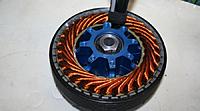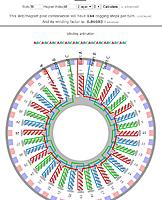|
|
|
|
Thread OP
|
Discussion
What kind of winding is this motor?
What kind of winding is this motor?
Is is nice! never seen this well organized winding on a rc brushless |
|
|
|
|
|
|
|
|
|
|
What kind of motor ?
|
|
|
|
|
|
|
|
|
Hi
Yes it is a Rotex RET30 30 slots 30 coils 40 magnets Scheme (ABC)x10 Classical windings You see all the transits (twisted multistrands wires) Probably 4 turns per tooth, delta connecting Another view Louis |
|
|
|
|
|
|
|
Thread OP
|
ok thanks!!!
it seems a 36 slot 48 poles, but it is the same scheme as 30 slots 40 poles |
|
|
|
|
|
|
|
|
A lot of work. Very neat

|
|
|
|
|
|
||
|
Thread OP
|
Quote:
- 36N34P, 36N38P - 36N42P, 36N30P - 36N24P, 36N48P but I know than 36N32P is also popular in hub motors. And 36N40P is very popular in multicopters So a lot of windings for the same stator!!! |
|
|
|
||
|
|
||
|
|
Quote:
Something I've wondered about for some years, having rewound brush type motors some 35 years ago to get more electric power, along with rewinding an automotive alternator to put out some 60 Volts 3 Phase. What limits the maximum current that can be pulled by these brushless motors we use for our electric models? I am aware that running to much voltage on a transformer can lead to saturating its magnetic core, causing very high current spikes, potentially causing smoke. So, is there an issue with our brushless motors where pulling to much current (or applying to much voltage) can saturate the motors magnetic iron path resulting in a significant drop in efficiency? Or worse? |
|
|
|
||
|
|
Quote:
The principal limit is the temperature rising, function of * load (torque+rpm) * running time duration (seconds) * voltage, rpm .. The problem of magnetic saturation (in laminations) is not well known nor well studied However, I have noticed that sometimes the no load losses versus rpm is growing up rapidly after a high rpm value Louis |
|
|
|
||
|
|
|
|
|
The maximum limit I see as the fusing current of the wire and the curie temperature of the magnets. Same thing (heat) In most of our real world modeling the limit is the speed control. Most of our motors if stalled on these "feminine" controllers will burn the majority of our set ups up.
 You can parallel all those partial motor groups. The goal always is maximum fill and minimum resistance. Staying under a mm in strand size and twisting of the wire will lower the ac resistance . A larger CCS will lower dc. So many poles and arms should have a relatively fine torque detent to fight through at low rpm. Low ripple as compared to some other possible combinations. Look there for the advantage. They may have the same scheme and wind factor but what is the cogging difference between the two if there is any. Check the advanced tab to view the subharmonics associated with the specific schemes to compare further. |
|
|
Last edited by H-1 (1boho); Sep 23, 2019 at 11:46 AM.
|
«
Previous Thread
|
Next Thread
»
| Thread Tools | |
| Similar Threads | |||||
| Category | Thread | Thread Starter | Forum | Replies | Last Post |
| Question | What wind is this motor? | pompebled | Racing Boats - Electric | 4 | Jul 15, 2016 07:04 AM |
| Help! | What kind of servo can I replace this with? | lichen | Electric Power Cars | 19 | Feb 26, 2016 01:22 PM |
| Discussion | What kind of Heli is this | SocalQuad | Electric Heli Talk | 6 | Nov 18, 2015 09:49 AM |
| Help! | What kind of truck is this | littlebill453 | Off-Road Vehicles | 2 | Oct 19, 2015 01:07 AM |
| Discussion | what do you fly in this kind of wind? | EZ Glider | Slope Soaring | 28 | Jan 06, 2008 07:38 PM |







